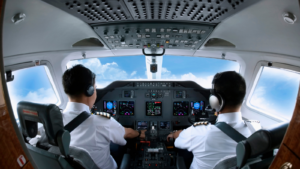Advancements in Aerospace Technology

As commercial space flights become increasingly popular, the future of aerospace technology looks increasingly promising. With growing public interest, the global space economy is expected to surpass $1 trillion by 2040. Overall, the aerospace industry has seen several major advancements in the last decade. From advanced materials to autonomous flights, here are some key trends to look for in aerospace technology.
What is Aerospace Technology?
Aerospace refers to the Earth’s atmosphere and outerspace. That means the aerospace industry is comprised of commercial flights as well as military aircraft, missiles, and space travel. The aerospace industry is incredibly complex and reaches several industries including fluid mechanics, astrodynamics, mathematics, engineering, electrotechnology, and materials science. 
Air travel is credited to the Wright Brothers, but the broader aerospace industry started in the late 1950s with the founding of the National Aeronautics and Space Administration (NASA). Before NASA, the United States government’s involvement in space was scattered. With the founding of NASA, the United States dedicated an agency to activities in space.
The U.S. government’s involvement in space exploration in recent years has been muddied by budget cuts and the addition of a new military branch. But NASA’s weary history has not stopped aerospace technology from advancing with the help of the private sector and other countries.
Key Advancements in Aerospace Technology
In 2021, there were 145 space launches, more than any other year in space exploration history since Sputnik. Here are some key advancements in aerospace technology from the last decade that have made the record-breaking launches possible.
-
Commercial space flights
Six of the 134 successful launches in 2021 were commercial or tourist space flights. Notable billionaires like Jeff Bezos, Richard Branson, and Elon Musk paved the way for commercial space flights with their respective private spacecraft companies.
In July of 2021, the first paying customer boarded Bezos’ Blue Origin spaceship for a quick trip into orbit. As aerospace technology continues to advance, we’ll see plenty more tourism flights in the near future.
-
Zero-fuel aircrafts
In 2016, the Solar Impulse Foundation successfully flew its plane around the world powered only by solar energy. The Foundation has been experimenting with zero-fuel aircraft since early 2010 with several successes. To achieve this remarkable journey, solar energy was stored in “lithium polymer batteries which are insulated by high-density foam and mounted in the four engine nacelles, along with a system to control charging thresholds and temperature.”
This technology has a long way to go before passenger airplanes are harvesting the sun’s energy to fuel their way around the world. However, Airbus is looking to add a zero-emission aircraft by 2035 that uses liquid hydrogen as fuel.
-
Autonomous flights
Planes have been flying on autopilot since the program became popular in the 1920s. Rapid advances in machine learning, cameras, sensors, and mapping are helping to make self-driving planes a reality.
In 2020, Airbus performed the first-ever fully automatic vision-based take-off. But the company warns that autonomous flights must gain public acceptance as aerospace technology evolves.
-
Advanced materials
During the Sputnik era of space exploration, traditional materials like steel and iron were favored for rockets, spacecraft, and aircraft. Advancing material technology can make aircraft more light and agile. Graphene and nanotubes are popular for aircraft as they make the aircraft wings more efficient, reduce the weight of the aircraft, and lower fuel consumption.
Technological advances in coatings also help protect satellites and missiles from the extreme conditions of space. An electrostatic dissipative (ESD) coating helps reduce static electricity and is ideally suited for aerospace applications requiring exceptional durability and heat resistance. ACI Materials provides aerospace coatings that offer superior abrasion, radiation, corrosion, and chemical resistance.
The ACI Advantage
ACI Materials offers aerospace coatings that are much more than paints. Our engineers have developed these materials specifically for aerospace technology. Download our data sheets on our ESD and thermal barrier coatings for more information.




